The Life Cycle of a Grape
One Year in the Vineyard
Winter DormancyDecember-February (May-Jul) | |
Winter PruningDecember-February (May-Jul) | |
Bud BreakMarch-April (Sep-Oct) | |
FloweringApril-May (Oct-Nov) | |
Fruit SetMay-June (Nov-Dec) | |
Canopy ManagementMay-August (Nov-Feb) | |
Ripening (Veraison)July-August (Jan-Feb) | |
HarvestingAugust-October (Feb-Mar) |
Winter Dormancy
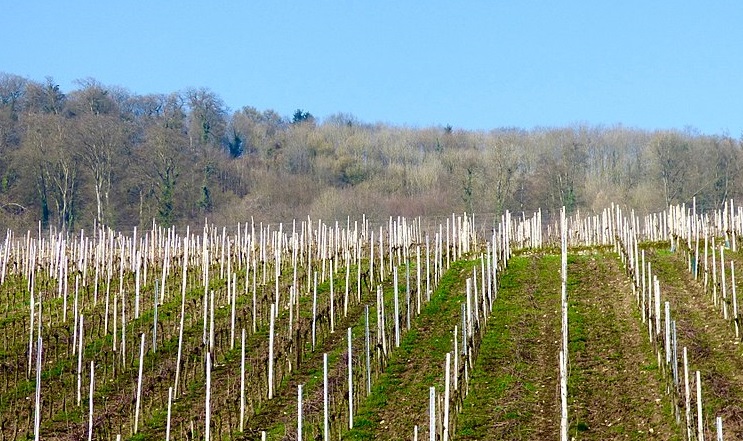
Sleeping vines at the Moselle (Mosel, Germany) in February.
The dormancy stage is from December to February (South: Jul-Sep).
The drop in temperatures triggers the dormancy stage. Nutrients (carbohydrates) are stored (in the cordon, trunk, and roots) and the vine loses water (dehydration) not to freeze and avoid winter frost damages.
Dormancy is a stage with no growth activity. The vine rests from autumn (leaf fall) to spring (bud burst).
Winter Pruning
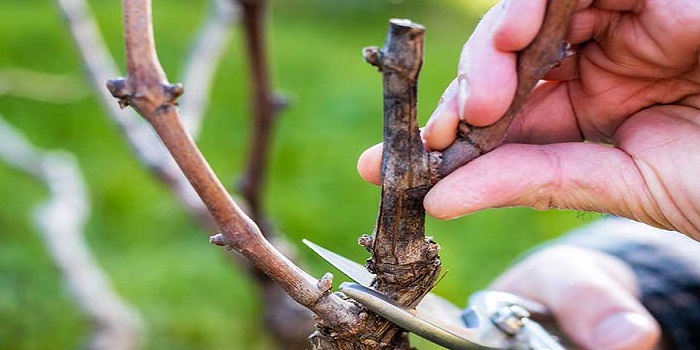
Winter pruning is a selective removal of 70-90% of the branches and buds.
The first round of winter pruning removes the majority of the canes to allow a more precise bud selection at a later pruning.
Pruning assures maximum energy and nutrients to the fully ripen grapes.
Fruit is produced only on shoots from one year old branches, so the goal of the pruning is to maximize their amount.
Too much vegetation could result in lack of nutrients, excessive shading, high crop load, uneven ripening or encourage diseases.
Bud Break (Budding - Budburst)
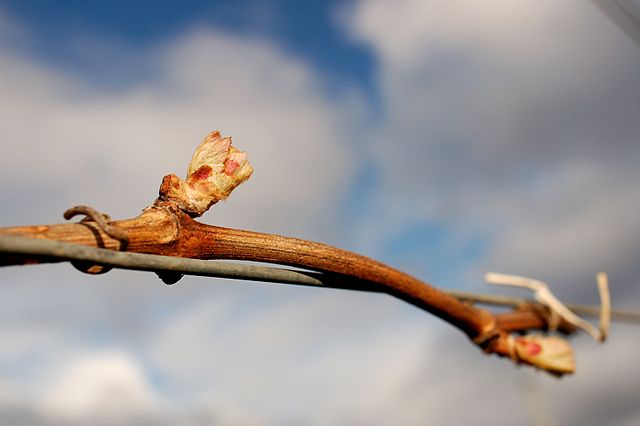
Budding is the first sign of life. The vine is weaking up and needs to produce leaves to generate carbohydrates via photosynthesis to fuel the new growth.
Bud Break happens in March-April (South: Sep/Oct) when daily temperatures reach 10 °C (50 °F).
As temperature and light increase, starches (stored carbyhydrates) are converted into sugar, and fluid begins to move in the vine.
The activity accelerates. Branches can grow 5-15 cm a day and buds swell and generate new shoots.
In this period, buds are delicate and vulnerable to frost and hailstorms.
In 2016, in Beaujolais in France, some vineyards lost up to 100% of their buds from hail.
Flowering
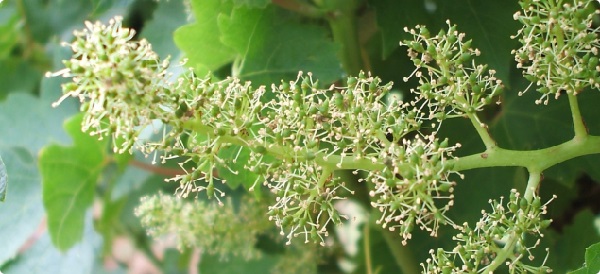
The flowering period can last one or two days in a warm and dry climate, or one month in a cool and wet climate.
April-May (Northern Hemisphere), October - November (Southern Hemisphere).
Flowering depends on the warmer temperature and stronger sunlight: a daily temperature of 15-20 °C (59–68 °F) activates the process.
Grapevine flowers bloom in a cluster 6 to 9 weeks after bud break.
Domesticated Vitis Vinifera varietals are hermaphroditic: the blossoms self-pollinate, without help from bees, because flowers are bisexual (have both sexes).
Pollen from a male flower (stamen) fertilizes the female flower (ovary), and a seed (embryo) develops. The entire ovary grows to become the grape berry itself with seeds contained within.
Flowers are delicate and vulnerable to harsh wind, cold and heavy rain.
Fruit Set
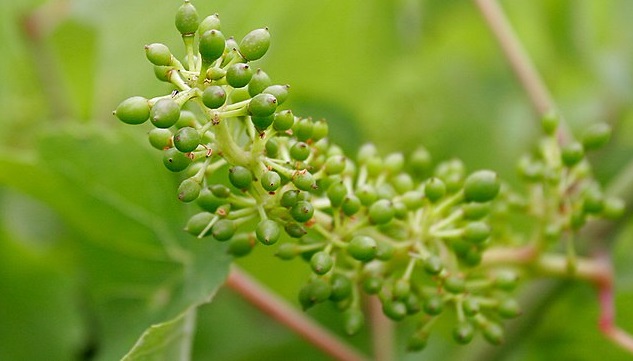
Small green peppercorn-sized berries grow bigger and harder, high in acid and low in sugar.
Fruit Set happens in May-June (South: Nov-Dec). It is the stage immediately after flowering.
As temperature rises, the growth accelerates, shoots expand and the vine starts to produce new nutrients via photosynthesis.
Canopy Management
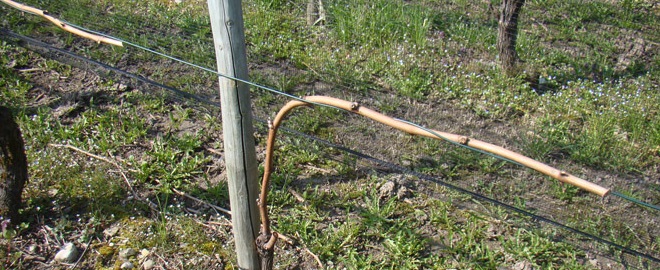
How to design the architecture of a grapevine and guide its energy into the ultimate result of perfectly mature fruit.
Canopy refers to leaves, shoots and fruit.
Most of the canopy management procedures take place from May to August (South: Nov-Feb).
Canopy Management Benefits
- Optimize the yield
- Improve the fruit quality
- Improve the sunlight exposure
- Provide good air circulation
- Reduce the risk of diseases
Canopy Management Methods
- Trellising
- Pruning
- Cluster Thinning
- Shoot positioning
- Leaf Removal
Trellising
Trellising is about fastening the branches to wires to maintain the best direction:
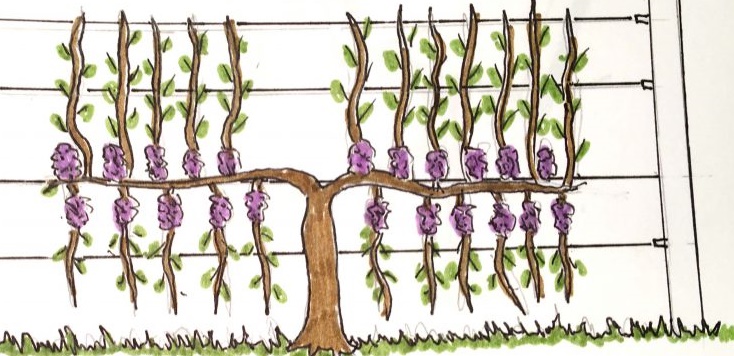
Cluster Thinning (Green Harvest)
From July to August, cluster thinning takes place to ensure optimal ripening.
Undersized an immature bunches are removed to save energy to the remaining (best quality) grapes.
Leaf Removing
Leaf removing assures higher quality wine.
It reduces the energy used on leaves, maximises the exposure to sunlight, provides good air circulation, and reduces the risk of diseases.
In cool climates it also helps the fruit to ripen by clearing the shade.
Ripening (Véraison)
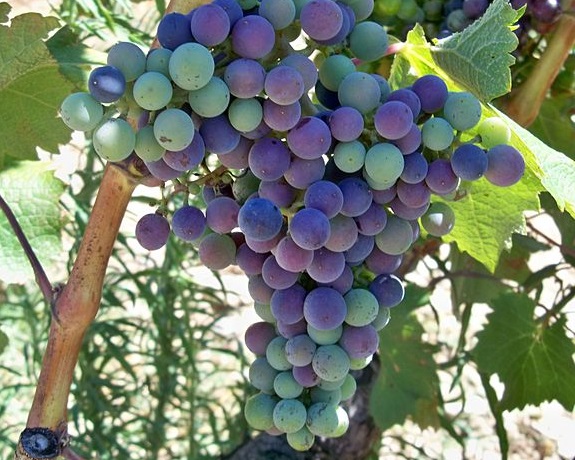
All grapes start out green. Then they turn yellow (white grapes) or pink, red, purple and black (red grapes).
Ripening happends in July/August (South: Jan/Feb).
It is the stage where the grapes begin to change color.
This is a signal of fruit maturation (ripening), berries begin to soften, acid level falls and sugar level rises.
The balance between sugars and acids is the most critical aspect to determine the quality of the wine. The longer the grape is on the vine, the higher the sugar and the lower the acidity will be.
Veraison is uneven (different degrees of ripeness) and the berries exposed to more sun and light get a head start.
Harvesting
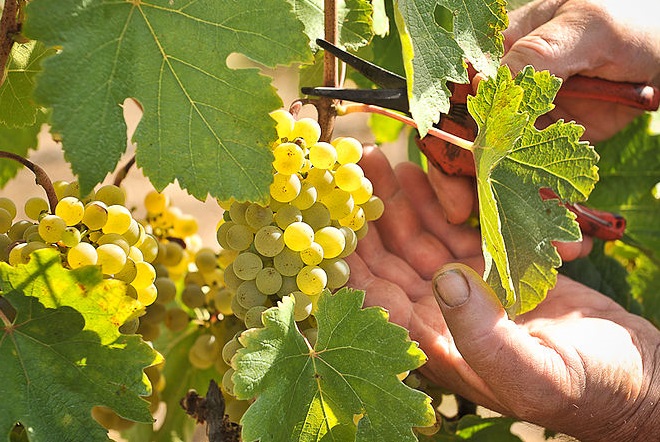
Hand picking Gruner Veltliner grapes at Hahndorf Hill vineyard in the Adelaide Hills.
The enologist chooses when to harvest, usually between August-October (South: Feb-Apr).
If you pick too early, the tannins are green and bitter. If you pick too late, the sugar level kills the acidity.
Sparkling wines need high acidity, so the harvest is early.
Dessert wines need high sugar, so the harvest is late.
The main factors are: maturity (skin thickness, berry texture, seed and stem color), optimal PH, sugar and acidity levels, optimal ripeness, wine style, weather forecasts, etc.
Generally it takes from one week to a month of hard labor. Once you start, you can't stop.
White grapes mature sooner and are normally harvested before black grapes that need more time to achieve the ideal color and sugar-acid balance.
The enemy at this stage is the fungal infection Botrytis that causes grapes to rot under rain-induced humidity.
Hand-picked grapes have better quality because grapes are delicate and break easily during machine harvesting. A broken grape skin results in premature start of fermentation.